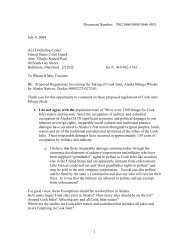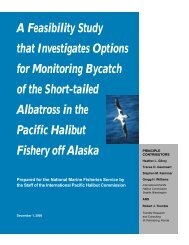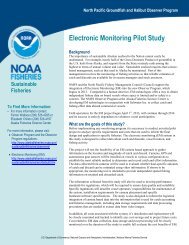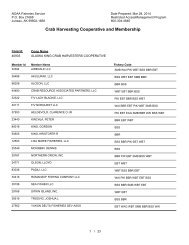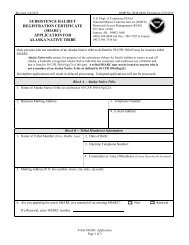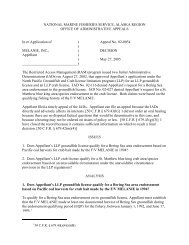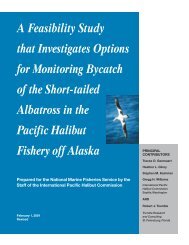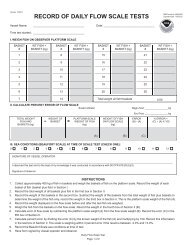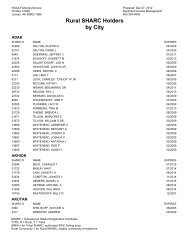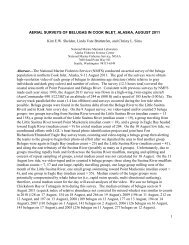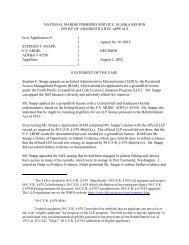Petition to List Lynn Canal Pacific Herring under the Endangered ...
Petition to List Lynn Canal Pacific Herring under the Endangered ...
Petition to List Lynn Canal Pacific Herring under the Endangered ...
You also want an ePaper? Increase the reach of your titles
YUMPU automatically turns print PDFs into web optimized ePapers that Google loves.
One important result of this study is <strong>the</strong> discovery of two genetically distinct<br />
geographic races of <strong>Pacific</strong> herring. Although several races or varieties of <strong>Pacific</strong><br />
herring have previously been described on <strong>the</strong> basis of morphological differences,<br />
none of <strong>the</strong> geographic ranges of <strong>the</strong>se varieties coincides with <strong>the</strong> geographic<br />
distributions of <strong>the</strong> two genetics races described in <strong>the</strong> present study.<br />
A rare Asian freshwater form has been described from Kamchatka, Sakhalin, and<br />
Hokkaido, among o<strong>the</strong>r locations, which penetrates in<strong>to</strong> rivers or freshwater lakes<br />
<strong>to</strong> spawn and overwinter (Berg 1948, Shmidt 1950, Sve<strong>to</strong>vidov 1952). This form<br />
has not yet been examined genetically nor has it been given taxonomic standing.<br />
The remaining forms of <strong>Pacific</strong> <strong>Herring</strong> are spring spawning and strictly marine.<br />
Populations of herring along <strong>the</strong> west coast of North America from <strong>the</strong> Bering Sea<br />
<strong>to</strong> California were described as a separate variety (C. p. mirabilis Girard), which<br />
was thought <strong>to</strong> consist of an uninterrupted series of transitional forms (Shmidt<br />
1950, Sve<strong>to</strong>vidov 1952, Andriyashev 1954).<br />
Two geographically isolated groups of <strong>Pacific</strong> herring have been described from<br />
<strong>the</strong> European section of <strong>the</strong> Arctic Ocean. Clupea p. maris-albi Berg occurs in<br />
<strong>the</strong> White Sea and C. p. suworowi Rabinerson occurs <strong>to</strong>ward <strong>the</strong> Kara Sea. These<br />
fish are often sympatric with migra<strong>to</strong>ry populations of Atlantic herring from <strong>the</strong><br />
coast of Norway but are morphologically and biochemically distinguishable from<br />
<strong>the</strong>m. Truveller (1979, cited in Altukhov and Salmenkova 1981) compared White<br />
Sea herring with <strong>Pacific</strong> and Atlantic herring using disc-gel electrophoresis of<br />
several proteins and confirmed that <strong>the</strong>y were more closely related <strong>to</strong> <strong>Pacific</strong><br />
herring than Atlantic herring.<br />
(Grant and Utter 1984).<br />
O’Connell et al. (1998) determined that significant genetic differences exist<br />
between and among <strong>Pacific</strong> <strong>Herring</strong> populations in Prince William Sound, Kodiak Island<br />
and <strong>the</strong> Bering Sea. This is in agreement with earlier work by Grant and Utter (1984). In<br />
addition, O’Connell et al. (1998) found significant genetic variation that showed<br />
population structuring within Prince William Sound.<br />
A comparison of pairwise Ө values revealed that <strong>the</strong> populations from outside <strong>the</strong><br />
Gulf of Alaska (Togiak Bay and Nor<strong>to</strong>n Sound) were approximately three times<br />
more distinct from populations within Prince William Sound than <strong>the</strong> Prince<br />
William Sound populations were from each o<strong>the</strong>r. The Ө values also revealed <strong>the</strong><br />
Kodiak Island and Port Chalmers samples <strong>to</strong> be relatively distinct from <strong>the</strong><br />
remaining Prince William Sound samples (Table IV).<br />
The R ST coefficient confirmed <strong>the</strong> high degree of genetic isolation between<br />
populations from <strong>the</strong> Gulf of Alaska and <strong>the</strong> Bering Sea and also confirmed <strong>the</strong><br />
relative distinctness of <strong>the</strong> Point Chambers and Kodiak Island samples from <strong>the</strong><br />
o<strong>the</strong>r Prince William Sound and Bering Sea samples.<br />
IV



